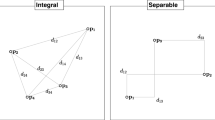Abstract
The INDSCAL individual differences scaling model is extended by assuming dimensions specific to each stimulus or other object, as well as dimensions common to all stimuli or objects. An “alternating maximum likelihood” procedure is used to seek maximum likelihood estimates of all parameters of this EXSCAL (Extended INDSCAL) model, including parameters of monotone splines assumed in a “quasi-nonmetric” approach. The rationale for and numerical details of this approach are described and discussed, and the resulting EXSCAL method is illustrated on some data on perception of musical timbres.
Similar content being viewed by others
References
AIKAKE, H. (1974), “A New Look at the Statistical Model,”IEEE Transactions on Automatic Control, 48, 575–595.
ARABIE, P., and CARROLL J. D. (1980), “MAPCLUS: A Mathematical Programming Approach to Fitting the ADCLUS Model,”Psychometrika, 45, 211–235.
CARROLL, J. D. (1976), “Spatial, Non-spatial and Hybrid Models for Scaling,”Psychometrika, 41, 439–463.
CARROLL, J. D. (1988), “Degenerate Solutions in the Nonmetric Fitting of a Wide Class of Models for Proximity Data,” Unpublished manuscript, AT&T Bell Laboratories, Murray Hill, NJ.
CARROLL, J. D., and ARABIE, P. (1983), “INDCLUS: An Individual Differences Generalization of the ADCLUS Model and the MAPCLUS Algorithm,”Psychometrika, 48, 157–169.
CARROLL, J. D., and CHANG, J. J. (1970), “Analysis of Individual Differences in Multidimensional Scaling via an N-way Generalization of Eckart-Young Decomposition,”Psychometrika, 35, 283–319.
CARROLL, J. D., and PRUZANSKY, S. (1980), “Discrete and Hybrid Scaling Models,” inSimilarity and Choice, Eds., E. D. Lantermann and H. Feger, Bern: Hans Huber, 108–139.
DE SOETE, G., (1988), “Tree Representations of Proximity Data by Least Squares Methods,” inClassification and Related Methods of Data Analysis, Ed., H. H. Bock, North-Holland: Elsevier, 147–156.
DE SOETE, G., CARROLL, J. D., and CHATURVEDI, A. D. (1993), “A Modified CANDECOMP Method for Fitting the Extended INDSCAL Model,”Journal of Classification, 10, 75–92.
DESARBO, W. S. (1982), “GENNCLUS: New Models for General Nonhierarchical Clustering Analysis,”Psychometrika, 47, 449–475.
DILLON, J. (1990), “Introitus,” London: Edition Peters No. 7408.
GILL, P. E., MURRAY, W., and WRIGHT, M. H. (1981),Practical Optimization, New York: Academic Press.
GREY, J. M. (1975), “An Exploration of Musical Timbre,” Unpublished manuscript, Ph.D. Dissertation, Stanford University, Dept. of Music Report STAN-M-2.
GUTTMAN, L. (1968), “A General Nonmetric Technique for Finding the Smallest Space for a Configuration of Points,”Psychometrika, 33, 465–506.
KIEFER, J., and WOLFOWITZ, J. (1956), “Consistency of the Maximum Likelihood Estimator in the Presence of Infinitely Many Incidental Parameters,”Annals of Mathematical Statistics, 27, 887–906.
KRUMHANSL, C. L. (1989), “Why is Musical Timbre So Hard to Understand?” inStructure and perception of Electroacoustic Sound and Music, Eds., S. Nielzen and O. Ohlsson, Amsterdam: Elsevier, 43–53.
KRUSKAL, J. B. (1964a), “Multidimensional Scaling by Optimizing Goodness of Fit to a Nonmetric Hypothesis,”Psychometrika, 29, 1–29.
KRUSKAL, J. B. (1964b), “Nonmetric Multidimensional Scaling: A Numerical Method,”Psychometrika, 29, 115–129.
KRUSKAL, J. B. (1976), “More Factors than Subjects, Tests and Treatments: An Indeterminacy Theorem for Canonical Decomposition and Indicidual Differences Scaling,”Psychometrika, 41, 281–293.
KRUSKAL, J. B., and CARMONE F. (1969), “How to Use M-D-SCAL (version 5M) and other Useful Information,” Unpublished manuscript, AT&T Bell Laboratories, Murray Hill, NJ.
KRUSKAL, J. B., and CARROLL, J. D. (1969), “Geometric Models and Badness-of-Fit Functions,” inMultivariate Analysis, Ed., P. R. Krishnaiah, New York: Academic press, 639–671.
KRUSKAL, J. B., YOUNG, F. W., and SEERY, J. B. (1977), “How to Use KYST-2A: A Very Flexible Program to do Multidimensional Scaling and Unfolding,” Unpublished manuscript, AT&T Bell Laboratories; Murray Hill, NJ.
NEYMAN, J., and SCOTT, E. L. (1948), “Consistent Estimates on Partially Consistent Observation,”Econometrica, 16, 1–32.
PRUZANSKY, S., TVERSKY, A., and CARROLL, J. D. (1982), “Spatial Versus Tree Representations of Proximity Data,”Psychometrika, 47, 3–24.
RAMSAY, J. (1978), “Confidence Regions for Multidimensional Scaling Analysis,”Psychometrika, 43, 145–160.
RAMSAY, J. (1980), “The Joint Analysis of Direct Ratings, Pairwise Preferences, and Dissimilarities,”Psychometrika, 45, 149–165.
RISSET, J. C. (1986), “Son Musical et Perception Auditive,”Pour la Science, 109, 32–51.
SCHWARTZ, G. (1978), “Estimating the Dimensions of a Model,”Annals of Statistics, 6, 461–464.
SHEPARD, R. N., and ARABIE, P. (1979), “Additive Clustering: Representation of Similarities as Combinations of Discrete Overlapping Properties,”Psychometrika, 86, 87–123.
TAKANE, Y., YOUNG, F. W., and DE LEEUW, J. (1977), “Nonmetric Individual Differences Multidimensional Scaling: An Alternating Least-Squares Method with Optimal Scaling Features,”Psychometrika, 42, 7–67.
WESSEL, D. L. (1973), “Psychoacoustics and Music,”Bulletin of the Computer Arts Society, 30, 1–2.
WESSEL, D. L., BRISTOW, D., and SETTEL, Z. (1987), “Control of Phrasing and Articulation in Synthesis,”Proceedings of the 1987 International Computer Music Conference, Computer Music Association, San Francisco, 108–116.
WINSBERG, S. (1988), “Two Techniques: Monotone Spline Transformations for Dimension Reduction in PCA and Easy-to-Generate Metrics for PCA of Sampled Functions,” inComponent and Correspondence Analysis, Eds., J. van Rijckevorsel and J. de Leeuw, London: Wiley, 115–135.
WINSBERG, S., and CARROLL, J. D. (1989a), “A Quasi-Nonmetric Method for Multidimensional Scaling of Multiway Data via a Restricted Case of an Extended INDSCAL Model,” inMultiway Data Analysis, Eds., R. Coppi and S. Belasco, North Holland: Elsevier, 405–414.
WINSBERG, S., and CARROLL, J. D. (1989b), “A Quasi-Nonmetric Method for Multidimensional Scaling via an Extended Euclidean Model,”Psychometrika, 54, 217–229.
WINSBERG, S., and RAMSAY, J. O. (1980), “Monotonic Transformations to Additivity Using Splines,”Biometrika, 67, 669–674.
WINSBERG, S., and RAMSAY, J. O. (1983), “Monotone Spline Transformations for Dimension Reduction,”Psychometrika, 48, 575–595.
Author information
Authors and Affiliations
Rights and permissions
About this article
Cite this article
Carroll, J.D., Winsberg, S. Fitting an extended INDSCAL model to three-way proximity data. Journal of Classification 12, 57–71 (1995). https://doi.org/10.1007/BF01202267
Issue Date:
DOI: https://doi.org/10.1007/BF01202267




